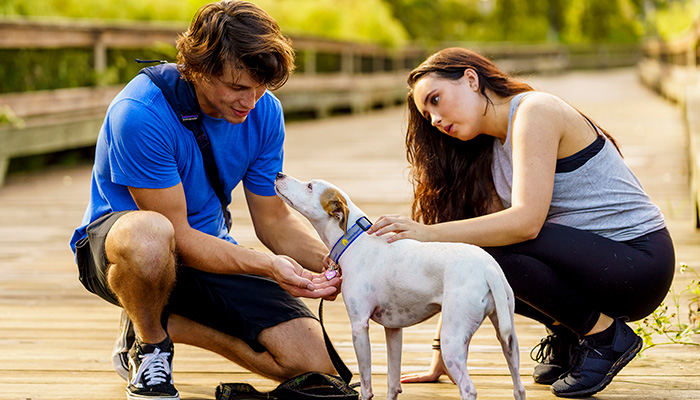
Learn about canine babesiosis, a tick-borne disease that affects dogs worldwide. Discover its symptoms, treatments, and how to prevent it.
As a dog owner, you’ve probably thought a lot about flea and tick prevention for your beloved pet. In addition to making your dog itchy and uncomfortable, fleas and ticks can also transmit serious diseases to your dog, which can sometimes even be fatal.
Different species of ticks can carry multiple different diseases. Babesiosis is caused by a parasite called babesia, which can be transmitted by certain kinds of ticks, depending on where you are located in the world.
Babesiosis occurs in domesticated dogs and wild canids on every continent, with the exception of Antarctica1. It is generally considered one of the most common and widespread of all the canine vector-borne diseases 2.
What is Babesiosis?
Canine babesiosis is a tick-borne disease that attacks a dog’s blood cells and causes a range of signs2.
How Does a Dog Become Infected with Babesiosis?
Tick bites are the most common source of infection for dogs, although babesiosis is occasionally transmitted through blood, such as through a blood transfusion or dog fighting.
Babesia is transmitted by ticks that have fed on infected dogs, whether or not they have signs of disease. Additionally, infected female ticks can lay thousands of eggs and pass the infection on to their own offspring as well, increasing the risk of transmission to other dogs1.
Dogs living in areas where there are lots of infected ticks have a high probability of becoming infected. When an infected tick bites a dog, they are not able to transmit Babesia immediately. Ticks must feed for 24-48 hours before Babesia is able to cross from the tick’s salivary glands to the dog3.
What Behaviors Put a Dog at Risk for Babesiosis?
Any dog that gets a tick bite is at risk of infection although infections are more common when dogs share their living spaces with numerous other dogs, such as in shelters and kennels. Also, dogs that have an active, outdoor lifestyle with frequent visits to natural environments where ticks are found face a higher risk of tick bites and subsequent infection. Dogs not protected by tick control treatments also face a higher risk of infection.
There may be some variations in breed-related susceptibility to tick bites and Babesiosis disease risk. For example, intact male dogs are more at risk than neutered males or females1, although this is possibly a result of increased roaming. Some breeds have been reported to have an increased prevalence of Babesia parasites such as Pit Bull Terriers, Staffordshire Terriers and their crossbreeds3.
Can a Dog Be Infected and Not Show Signs?
Babesiosis infections can be fatal, although many infected dogs do not develop any signs of disease. The presence of antibodies may be found in a blood test at the veterinary hospital in dogs that seem healthy but are actually infected.
A positive test reveals that the dog had a tick bite that resulted in an infection. This likely means that most dogs infected will remain infected for life despite treatment3. While these dogs may seem healthy, they can still create additional local disease risks by spreading the infection to local ticks. Previously infected dogs can succumb to the disease again under periods of stress or immunosuppression.
What are the Signs of Babesiosis3?
The severity of babesiosis ranges from mild infections to widespread organ failure and death. Infected animals develop some level of anemia, and some develop specific organ pathologies.
Other factors that will contribute to a dog’s outcome include age and immune status, the presence or absence of co-morbidities (such as immunosuppressive problems), and presence of other tick-borne infections. Also, young dogs tend to be more severely affected than adults.
Dogs with clinical disease caused by Babesiosis may show the following symptoms:
- Lethargy
- Appetite loss
- Weakness (sometimes progressing to where the dog collapses)
- Dark-colored urine
- Pale mucous membranes in the eyes, gums, mouth
What are the Treatments for Sick Dogs3?
Treatment for babesiosis generally includes administration of specific antiprotozoals and antibiotics in combination with supportive treatment, which restores adequate tissue oxygenation by correcting anemia, dehydration and electrolyte disturbances, if present.
Other treatments in the regimen may include:
- Blood transfusions
- Fluid therapy
- Oxygen therapy
- Treating tick infestations
Good nursing support is also crucial to a dog’s recovery which should include keeping the dog warm and feeding him/her a nutritious, balanced diet.
Are Other Pets or People in The House at Risk?
Babesiosis is not contagious like a cold or a flu, although parasites may be transmitted through bite wounds. The presence of an infected dog does indicate a risk to other dogs in the household from tick-bite transmission, so treating and eliminating all tick infestation is vital.
Currently, the species of Babesia that infects dogs is not the same species that infects humans, but dog owners should be aware of the risks they face from infection of babesia and tick bites2.
How Do I Prevent Babesiosis Infections in My Dog?
The best solution to help prevent Babesiosis infections in your pet is a consistent, effective tick treatment.
Other things you can do to prevent tick infections in your pup include:
- Avoid wooded or grassy areas to reduce the risk of tick bite and subsequent infection.
- Examine your dog frequently for ticks, especially after visiting potential areas of infestation like kennels, parks frequented by dogs or wildlife, or other heavily vegetated areas. Remove ticks as soon as they are found.
- Ensure that all dogs using shared animal facilities, such as doggy day care, boarding kennels, or dog parks, receive tick control treatments to reduce the likelihood of tick infestation.
- Use tick control treatments all year long because it is difficult to precisely predict when ticks will be out feeding.
- Get your dog checked by a veterinarian. Early detection of tick infections in dogs can be very helpful in reducing disease risks and ensuring treatment is started if needed.
References:
1. Irwin, Peter. Canine Babesiosis in the Developed World. (2020). Canine Babesiosis in the Developed World. [White paper].
2. Center for Disease Control and Prevention. 31 Mar. 202. Parasites – Babesiosis. https://www.cdc.gov/ parasites/babesiosis/.
3. Companion Animal Parasite Council. 26 Mar. 2019. Babesia SPP. https://capcvet.org/guidelines/babesia/.
Copyright © 2022 Merck & Co., Inc., Rahway, NJ, USA and its affiliates. All rights reserved.

